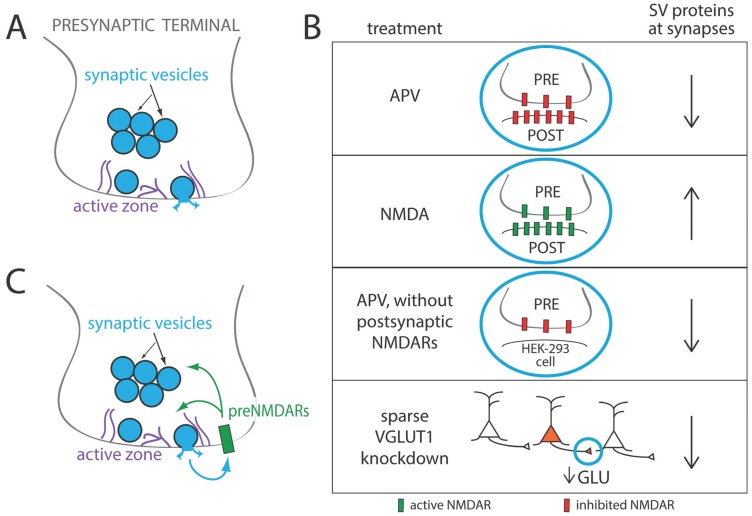Figure 1.
(A) Presynaptic terminals (or boutons) are specialized structures that form within axons at sites of synaptic contact with postsynaptic partners. Presynaptic terminals contain clusters of small synaptic vesicles that are loaded with small molecule neurotransmitters, such as glutamate and GABA. When an action potential invades the presynaptic terminal, synaptic vesicles fuse with a region of the plasma membrane known as the active zone, and a neurotransmitter is released into the synaptic cleft where it can bind to its receptors. Synaptic transmission occurs upon binding of receptors within the postsynaptic membrane; however, presynaptic neurotransmitter receptors also exist. The probability that a vesicle fuses in response to an action potential is known as the probability of release, and the postsynaptic response induced by fusion of a single vesicle is referred to as a miniature excitatory postsynaptic current, or mEPSC; (B) Presynaptic development is regulated by NMDA receptor activation, even when presynaptic terminals are formed with postsynaptic partners that lack NMDA receptors. Treatment of cortical neurons with APV, an NMDA receptor antagonist, reduced accumulation of synaptic vesicle and active zone proteins at developing synapses, while treatment with the NMDA receptor agonist NMDA did the opposite [14]. When cortical neurons formed presynaptic terminals with non-neuronal HEK-293 cells that express neuroligin but not NMDARs, treatment with APV reduced synaptic vesicle protein content at these terminals. When VGLUT1 was knocked down in individual cortical neurons in culture to reduce synaptic glutamate release, presynaptic terminals formed by those neurons had reduced synaptic vesicle protein content. This indicates that presynaptic development is regulated by glutamate release in a cell-autonomous manner [15]; (C) Based on these observations, we hypothesize that presynaptic NMDA receptors may facilitate presynaptic development.

